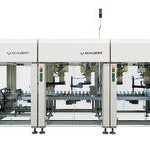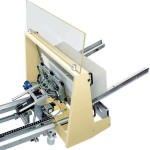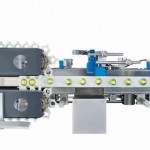TLM packaging machines were launched in January 2002 and have been successfully utilised in the pharmaceutical industry since 2004. In the six years since they appeared in the market their career has been characterised by what is probably an unprecedented level of development investment.
The story of how the TLM packaging machine series evolved goes back to one day in 1959 when Gerhard Schubert first mooted to an older colleague the idea of inventing a modular system for this kind of equipment. Despite being met with no more than a derisory smile, his vision continued to haunt him. When he founded his own company in 1966, he lost no time in putting his project into practice. His first approach was to create mechanical modules in large numbers which were used to configure top-loading machines. This led him to the realisation at the end of the seventies that the only genuine way forward was through robot technology. By 1984, a decisive milestone had been reached: his first packaging robot functioned like clockwork, heralding a new era in packaging machine technology. Even the very first packaging robot models were equipped with a control system, confirming that true flexibility could only be achieved by underpinning mechanics with intelligent controls. The end of the nineties saw the emergence of a new philosophical direction in which machines began to be designed to emulate human characteristics. Simple mechanisms, intelligent control systems and exchangeable tools were used, and the TLM packaging machine system was born. Today, the system – incidentally the three letters TLM stand for Top Loading Machine – comprises just seven modules, namely:
- Transfer unit
- Grouping chain
- TLM-F2 packaging robot
- TLM-F44 robot
- Vision system
- Vacuum conveyor
- Machine frame
- Operator guidance system
Transfer unit
In the past, no particular importance was ever attached to the transfer of packaging materials to the packaging line, as in any case this process had to be reconfigured for every new application. However, with the development of TLM technology, a significant component was created: the flexible transfer unit, a true two-axis robot. Flat box blanks, plastic trays, reinforcing cards, brochures – anything that needs to be transferred is inserted into the unit’s stacking magazine. The magazine comprises the actual magazine plate, an exchangeable component (tool), the transport rails with their level control sensors and the transfer tool – an exchangeable suction plate. The magazine can be moved out of the machine for tool changeover, which takes around three minutes.
Grouping chain
It was only with the advent of robot technology that the concept of grouping chains to allow optional grouping of individual products became a feasibility. The functional principle is a simple one. Products run into transport cells (tools) which are mounted on two chain lines. Once the required number of products for a group has been collected in one of the lines, they move to the pick-up position. One of the tasks of the control system is to monitor the product spacing and eject products where necessary – a challenging task at high infeed rates. The grouping chain is offered in a horizontal and a vertical version. The trend towards transposing mechanical functions into software applications is meanwhile also gaining ground in the packaging machine sector. Taking this a stage further, grouping chains themselves are likely to give way to vision systems in the foreseeable future.
Robot units
The first packaging robot was a four-axis model developed and constructed at the end of the seventies. Unveiled for the first time at Interpack 1981 and sporting the name Robby, the unit excited considerable interest in the industry. Today, it bears the type designation TLM-F4 robot unit. Equipped with a carbon fibre arm, it is capable of accelerating a mass of 10 g at a speed of 5 m/s. And as you would expect of a robot, it does all this with practically no noise. The F4 unit, also known as a picker, generally comes exclusively in the form of a double pack regulated by a control system – a double F4 or F44 picker station. While in former times the unit’s zero point had to be laboriously reset with every change of motor, this now takes place fully automatically.
Schubert’s vision system is used in conjunction with the TLM-F44 robot unit. It is capable of processing around 4000 products per minute with the aid of an incident or transmitted light scanner. The incident light scanner is a colour scanner which supplies a three-dimensional picture. The packaging machine operator can specify certain quality characteristics for the image processing system to take into consideration, ensuring that only flawless products are ever picked off the infeed conveyor. As well as the precise position and rotational angle of the products, the surface dimensions and contour data are compared to the specified values and transmitted to the robots.
When the F2 was first launched in 1984, it was classified as a robot. Then, as it only had two axes, it was demoted to a movement unit. After proving its value many thousands of times over in practical operation, it was restored to the status of robot. In actual fact, it has been far more successful over the years than its four-axis counterpart, proving once again the truth behind the rule that flexibility increases with decreasing mechanical complexity. The TLM-F2 robot unit can be used for box erecting, filling and lidding. It features an ingenious tool actuation system designed to accommodate easily exchangeable product-specific tools.
Vacuum conveyor
The invention of the vacuum conveyor in 2003 was a further milestone in Schubert’s history. The erecting tool transfers the box directly to the suction plates of the vacuum conveyor. Fixed at the base by vacuum, the box is conveyed to the various workstations, eliminating the need for lateral guides and holding-down devices. The suction plates are configured as exchangeable transport tools, offering a positioning accuracy of 0.1 mm. They are capable of travelling at up to 9 m/s between two stations. As a rule, a vacuum conveyor comprises three individual transport units. Labelling, printing or reading functions can easily be performed while the box is being transported.
Space-saving design
The machine frame is welded together from sheet metal components to create a stable, low-vibration cell. The less space required for a packaging machine, the better. The control cabinets in the TLM machines have therefore been moved upwards. The robot units are accommodated in-between and the whole frame mounted on four legs. The internal space between the legs is secured by Perspex doors. Carrier rails form the base platform for the machines, and also support other assemblies. A packaging machine or line generally consists of several frames, each one an easily transportable unit. The machine frames are offered in nine different widths and five lengths, and painted in any required colour finish. For use in damp or humid conditions and for the pharmaceutical industry, the machine frames are made of stainless steel (V4A).
Operation and control
The operator guidance system constitutes the man-machine interface and encompasses far more than simply an operator terminal. A TLM machine is switched on and off using the two pushbuttons in the green area. On/off switching processes are independently controlled by the machine. The 15 inch touch screen provides a wide range of information which can be accessed by the operator. When maintenance work is due, the oil can icon changes colour. The operator guidance system, which is a tried-and-tested industrial PC, also stores the entire range of resetting programs for the TLM machine. The display language can be changed as required using a language selection function. A complete set of operating instructions can be accessed on screen, including spare parts lists. The graphic representation of the machine on the touch screen provides detailed information about the machine operating status at any time.
TLM packaging machines are fitted with a decentralised control system. Decentralised in this context means that every assembly has its own control system and that all control systems are linked to one another by an optical bus as well as to a host computer. Up to 50 % cost savings for installation and commissioning, fast response times and simple troubleshooting and rectification of errors are the most important benefits of this concept. The host computer of the TLM system is responsible for operator prompting. The control panel is the interface between man and machine, behind which is a personal computer that virtually eliminates any possibility of operator errors. In future, the TLM packaging machines will be equipped with a system for automatic tooling exchange that will be presented at Interpack 2008. There are also innovations concerning the machine control. It will not be long before plug-in connections, which as a rule are interference-prone, can be dispensed with and replaced by data and power transmission of control signals based on Bluetooth technology.
cpp 439
TLM packaging machines and their components
Interpack processes and packaging
Share:









